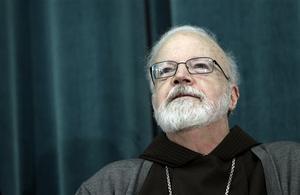Joann Fitzpatrick: a Modern Miracle for Cardinal O'Malley?
By Joann Fitzpatrick
COMMENTARY — Traditionally the election of a new pope gives the Roman Catholic hierarchy a chance to remind the world of one of its great religions and of how much influence the Vatican has. Until fairly recently, the gathering of cardinals, the procession of red hats into St. Peter’s Basilica, crowds waiting for the puff of white smoke to indicate that a new leader has been chosen – all the attendant rituals and the secrecy of the process made for great theater. A sense of the mystique of the church pervaded. Not this time. A measure of inscrutability is present in all religions and helps sustain them and their followers in the modern world. But events in recent years have stripped the Vatican of the mystery cloak that sheltered it so securely. We always knew there was intrigue; it’s been the stuff of lore and literature for centuries. Now we know of financial scandal and, most alarming, of the persistent and worldwide cover-up of sexual abuse by priests. What happens at the Vatican no longer stays at the Vatican, and what happens in the conclave to select a new pope is of far less interest than it used to be, even among the faithful. The men who run the church may use Twitter, but their outlook remains rooted in another time. They refuse to acknowledge that their efforts to keep Catholics tightly controlled have failed. Most Catholics practice their faith as they know and feel it, distanced emotionally and theologically from the Vatican managers who are so removed from the lives of their followers. These men rail against contraception as though they don’t know that the vast majority of Catholics in developed countries turn a deaf ear. Italy has one of Europe’s lowest birth rates, and it’s not because of the Mediterranean diet. The patriarchs continue to oppose marriage for priests and the ordination of women even as the number of men entering the priesthood declines precipitously. In another generation, the question will not be whether to close churches for financial reasons but whether to close them because there is no priest to say Mass. In the face of such gargantuan issues, is it possible that the cardinals could turn to a different kind of pope? It’s exciting that Boston’s Cardinal Sean O’Malley is being talked about as a possibility, though he’s highly unlikely to be chosen. The prospect of his election has appeal for those who desperately wish for a less doctrinaire pope after Benedict XVI. American Catholics understand well that there is no such thing as conservative cardinals and liberal cardinals. But while the church represented at the Vatican is essentially an immovable object, there are shades of gray among the scarlet. Cardinal O’Malley is decidedly different from those cardinals who enjoy the role of “princes” of the church. He wears the brown robe and sandals of a friar and practices the simplicity for which monks are known. He speaks softly but has a proven ear for what the church needs at this time. His most dramatic act as archbishop of Boston was to sell off the grand mansion local bishops had called home for decades and to move the church headquarters to an office park in Braintree. This was more than a gesture: The archdiocese needed the money to help pay the cost of lawsuits stemming from the sex abuse scandal. But beyond that, the church needed to show a recognition that the trappings were too grand, that it had to focus on repairing and reforming itself as well as paying reparations. The sex abuse scandal exploded first in the Fall River diocese in 1990, with revelations that the Rev. James Porter had abused scores of boys and girls while in a Roman collar. Porter was long gone from Fall River and the priesthood, but his accusers brought him back. He went on trial in 1992, just after Sean Patrick O’Malley was named bishop of Fall River. Bishop O’Malley dived into the role of healer and set policies to assure that priests accused of sex crimes would not be concealed or shuffled by the church from place to place. As the sex abuse scandal has become worldwide, Cardinal O’Malley’s reputation as a reformer has become well known. Choosing a man who dealt with these ugly crimes in a responsible manner would signal a church ready to face the modern world – something Pope Benedict will never be accused of. The Catholic Church is an institution as averse to surprise as it is to change. But still, it does believe in miracles Contact: joannftzptrck@yahoo.com.
|
.
Any original material on these pages is copyright © BishopAccountability.org 2004. Reproduce freely with attribution.
